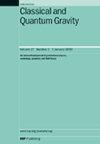Automated evaluation of environmental coupling for Advanced LIGO gravitational wave detections
IF 3.6
3区 物理与天体物理
Q2 ASTRONOMY & ASTROPHYSICS
引用次数: 0
Abstract
The extreme sensitivity required for direct observation of gravitational waves by the Advanced LIGO detectors means that environmental noise is increasingly likely to contaminate Advanced LIGO gravitational wave signals if left unaddressed. Consequently, environmental monitoring efforts have been undertaken and novel noise mitigation techniques have been developed which have reduced environmental coupling and made it possible to analyze environmental artifacts with potential to affect the 90 gravitational wave events detected from 2015–2020 by the Advanced LIGO detectors. So far, there is no evidence for environmental contamination in gravitational wave detections. However, automated, rapid ways to monitor and assess the degree of environmental coupling between gravitational wave detectors and their surroundings are needed as the rate of detections continues to increase. We introduce a computational tool, PEMcheck, for quantifying the degree of environmental coupling present in gravitational wave signals using data from the extant collection of environmental monitoring sensors at each detector. We study its performance when applied to 79 gravitational waves detected in LIGO’s third observing run and test its performance in the case of extreme environmental contamination of gravitational wave data. We find that PEMcheck’s automated analysis identifies only a small number of gravitational waves that merit further study by environmental noise experts due to possible contamination, a substantial improvement over the manual vetting that occurred for every gravitational wave candidate in the first two observing runs. Building on a first attempt at automating environmental coupling assessments used in the third observing run, this tool represents an improvement in accuracy and interpretability of coupling assessments, reducing the time needed to validate gravitational wave candidates. With the validation provided herein; PEMcheck will play a critical role in event validation during LIGO’s fourth observing run as an integral part of the data quality report produced for each gravitational wave candidate.高级 LIGO 引力波探测环境耦合自动评估
高级 LIGO 探测器直接观测引力波所需的极高灵敏度意味着,如果不加以解决,环境噪声越来越有可能污染高级 LIGO 引力波信号。因此,已经开展了环境监测工作,并开发了新的噪声缓解技术,这些技术降低了环境耦合,使分析可能影响高级 LIGO 探测器在 2015-2020 年期间探测到的 90 个引力波事件的环境伪影成为可能。迄今为止,还没有证据表明引力波探测器受到了环境污染。然而,随着探测率的不断提高,我们需要自动、快速的方法来监测和评估引力波探测器与其周围环境之间的环境耦合程度。我们介绍了一种名为 PEMcheck 的计算工具,利用每个探测器上现有的环境监测传感器收集的数据来量化引力波信号中的环境耦合程度。我们研究了该工具应用于 LIGO 第三次观测运行中探测到的 79 个引力波的性能,并测试了它在引力波数据受到极端环境污染的情况下的性能。我们发现,PEMcheck 的自动分析只识别出了一小部分由于可能的污染而需要环境噪声专家进一步研究的引力波,与前两次观测运行中对每个引力波候选天体的人工审核相比,这是一个重大改进。在第三次观测运行使用的环境耦合评估自动化首次尝试的基础上,该工具提高了耦合评估的准确性和可解释性,减少了验证引力波候选体所需的时间。通过本文提供的验证,PEMcheck 将在 LIGO 第四次观测运行期间的事件验证中发挥关键作用,成为为每个引力波候选天体生成的数据质量报告的组成部分。
本文章由计算机程序翻译,如有差异,请以英文原文为准。
求助全文
约1分钟内获得全文
求助全文
来源期刊

Classical and Quantum Gravity
物理-天文与天体物理
CiteScore
7.00
自引率
8.60%
发文量
301
审稿时长
2-4 weeks
期刊介绍:
Classical and Quantum Gravity is an established journal for physicists, mathematicians and cosmologists in the fields of gravitation and the theory of spacetime. The journal is now the acknowledged world leader in classical relativity and all areas of quantum gravity.
文献相关原料
| 公司名称 | 产品信息 | 采购帮参考价格 |
|---|
 求助内容:
求助内容: 应助结果提醒方式:
应助结果提醒方式:


